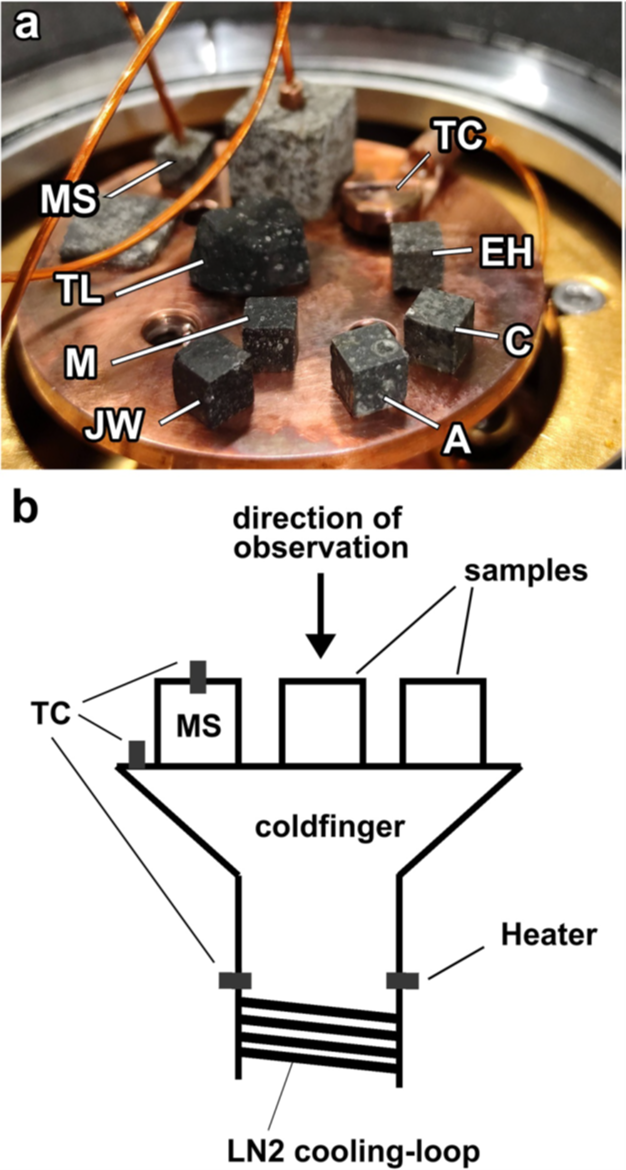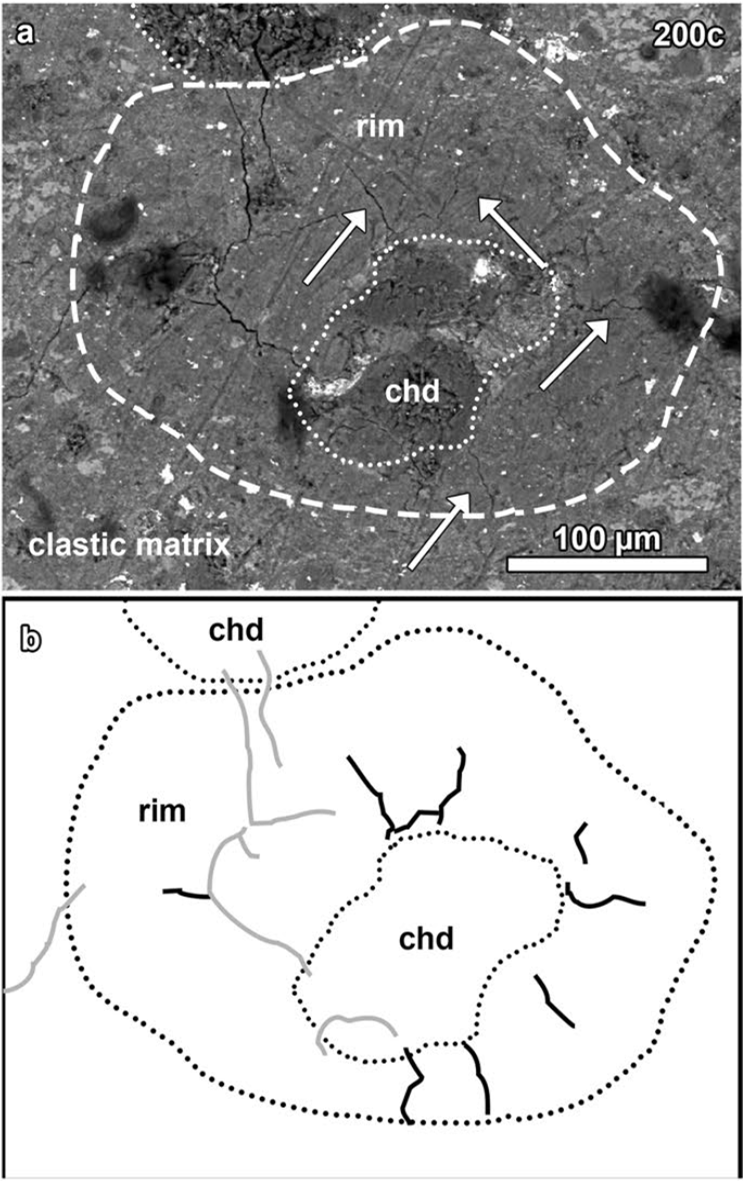On the Response of Chondrites to Diurnal Temperature Change—Experimental Simulation of Asteroidal Surface Conditions
- 1Institut für Planetologie, Universtität Münster, Germany (markus.patzek@uni-muenster.de)
- 2Planetary Science Institute, Tucson, AZ, USA (jmolaro@psi.edu)
Introduction:
The surface of planetary bodies is constantly altered by a number of different processes including (micro) meteorite impacts leading to effects such as abrasion, shattering, brecciation [1-8], proton bombardment [e.g., 9], and diurnal temperature variations [10,11]. The diurnal temperature variation is resulting in sub-critical crack growth due to mineral and rock heterogeneities. These effects of thermal fatigue related rock breakdown have been recently studied for various aspects (rapid temperature change, crack geometry, and particle ejection [12-15]. This study investigated the crack growth on the surface of various chondrite samples in order to understand the aspect of petrology of different rocks within the context of thermal fatigue-driven rock breakdown due to diurnal temperature variations. Additionally, the experiments were performed under vacuum conditions to eliminate potential effects of atmosphere present in previous experimental studies [10,15], which have been demonstrated to affect heat transfer and cracking behavior.
Methods and Samples:
The experiment is based on a LN2-cooled, evacuated (<5x10-5 mbar) cryostat and a 100W cartridge heater installed in the base of a cold finger (16). Sample cubes, previously investigated by scanning electron microscopy (SEM) with sizes of ~5x5x5 mm³ are placed on the copper cold finger. Temperatures of the whole experiment are measured by thermocouples on different locations in the chamber and on a 5 mm monitored sample. The cold finger setup is illustrated in Fig. 1. The samples are cycled from 175 K to 375 K (cycle length ~200 min) and investigated via SEM after 0, 10, 20, 50, 100, 200 and 400 cycles, respectively. For observation of the top surface (i.e., the opposite side of heating) of the sample cubes, a JEOL 6610-LV scanning electron microscope (SEM) was used to obtain a sample mosaic, derived from back scattered electrons (BSE). The length of cracks on the surface of the sample cubes have been studied opposite to [10] since the detection of those cracks in the µCT scans was not reliable enough.

Fig. 1: (a) Photograph of the cold finger and samples placed on it. (b) Illustration of the cold finger design and viewing geometry. TC=thermocouple; MS=monitored sample; Other abbreviations refer to sample names.
Different samples representative for various asteroids classes have been chosen to study the effect of diurnal temperature variations including aqueously-altered CM2 and C2 chondrites as well as ordinary and CV chondrites: Murchison (CM2), Jbilet Winselwan (CM2), Tagish Lake (C2ung), Allende (CV3), El Hammami (H5), and Chelyabinsk (LL5). From several cubes those matching the experimental criteria (sample geometry and “meteorite group-typical” mineralogy) have been selected for the experiment.
Results:
The obtained SEM-BSE images revealed cracks nucleating at different locations and propagating through the sample leading to increases in the crack length and width. Additionally, closing of cracks has also been observed. However, these observations were limited only to aqueously-altered chondrites, which are, Murchison (CM2), Jbilet Winselwan (CM2), and Tagish Lake (C2ung), while no changes were detected for the ordinary and CV chondrite(s). For CM2 chondrites (e.g., Murchison), we observe crack patterns that diverge radially from chondrules into fine-grained rims and further into matrix (e.g., Fig. 2).

Fig. 2: (a) BSE image of a chondrule in Murchison with its fine-grained rim and the clastic matrix surrounding it. (b) Illustration of cracks that were present before cycling (grey) and newly formed cracks in black after total cycles. chd=chondrule.
Discussions:
Compared to previous experiments using similar approaches [e.g. 10,16,17,18], some major differences are visible that can be attributed to different aspects: I) the absence of “micro-flaking” observed by [16] on (achondritic) lunar and eucrite meteorites, which is possibly related to the “primary” character of the here studied rocks, i.e., the absence of large scale differentiation or melting processes. II) Terrestrial weathering (as indicated by enhanced cracking rates) has a major impact on the crack formation and should be considered in more detail before using meteorites as analogue materials for asteroids surface. III) The radial cracking around chondrules in CM2 chondrites is a striking observation considering the modelling of internal stress fields, which as implications on the resulting shapes and sizes of grains and fragments. IV) Closing of cracks in Tagish Lake due to the diurnal cycling has never been reported before and several attempts of explanation can be considered.
Conclusions:
We will present a subset of these results and their implications for the mechanisms and shapes of produced particles on CM-like asteroids, the life times of boulders on asteroids, and the influence of hydrated minerals on atmosphereless planetary surfaces.
References:
[1] Hörz, F. et al. (1975) The Moon, 13(1–3), 235–258. [2] Keil, K. (1982) In Lunar Breccias and soils and their meteoritic analogs (p. 65). [3] Horz, F., & Cintala, M. (1997) Meteoritics & Planetary Sciences, 32(2), 179–209. [4] Bischoff, A et al. (2006) Meteorites and the Early Solar System II, 679–712. [5] Bischoff, A. et al. (2018) Geochimica et Cosmochimica Acta, 238, 516–541. [6] Cambioni, S. et al. (2021) Nature, 598(7879), 49–52. [7] Rüsch, O., & Wöhler, C. (2022) Icarus, 384, 115088. [8] Rüsch, O. et al. (2022) Icarus, 387, 115200. [9] Barghouty, A. F et al. (2011) Nuclear Instruments and Methods in Physics Research Section B: Beam Interactions with Materials and Atoms, 269(11), 1310–1315. [10] Delbo M. et al. (2014) Nature 508:233-236. [11] Molaro J. L. et al. (2015) Journal of Geophysical Research 120:255-277. [12] Molaro, J. L. et al. (2017) Icarus, 294, 247–261. [13] Molaro, J. L. et al. (2020) Journal of Geophysical Research: Planets, 125(8). [14] Molaro, J. L. et al. (2020). Nature Communications, 11(1), 1–11. [15] Libourel, G. et al. (2021). Monthly Notices of the Royal Astronomical Society, 500(2), 1905–1920. [16] Patzek, M., & Rüsch, O. (2022) Journal of Geophysical Research: Planets, 127(10). [17] Hazeli, K. et al. (2018) Icarus, 304, 172–182. [18] Liang, B. et al. (2020) Icarus, 335, 113381.
Acknowledgements: M.P and O.R are supported by the Sofja Kovalevskaja Award Project of the Alexander von Humboldt Foundation. Part of this research was supported by the NASA Solar System Exploration Research Virtual Institute 2016 (SSERVI16) under cooperative agreement 80ARC0M0008.
How to cite: Patzek, M., Rüsch, O., Molaro, J. L., and Gundlach, B.: On the Response of Chondrites to Diurnal Temperature Change—Experimental Simulation of Asteroidal Surface Conditions, Europlanet Science Congress 2024, Berlin, Germany, 8–13 Sep 2024, EPSC2024-292, https://doi.org/10.5194/epsc2024-292, 2024.